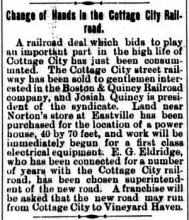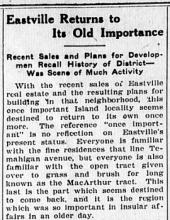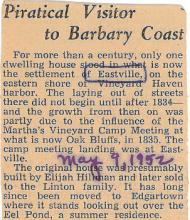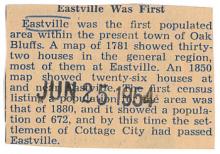All Oak Bluffs roads lead to the lobster hatchery; according to the signs, the first state lobster hatchery ever to be instituted, and this is the truth. Much as been written about this novel hatchery in consequence of which there are many visitors, all of them welcome.
But these visitors, arriving for the first time may well have been astonished to discover that a few yards away lies a burying ground, a cemetery, the extent of which is known to no one, although necessary excavations in the vicinity have established the fact that it is far larger than it seems. As it is, a few graves are identified by either graven or field-stone markers, while others may be partially identified by suspicious looking mounds or hollows, as the case may be. Articles have been written about this burying ground and it has been mentioned in various books, but actually nobody knows all about it and probably no one ever will.
Delving back into history as far as either the written record or local tradition will serve as a guide, two things become apparent. First, that all this area was a farming district, and sparsely populated in the early days of Vineyard history. Included in the township of Edgartown, it was a “poor relative” in every sense of the word, despite the fact that some of the most wealthy and influential men of the Island owned land there and, indeed, had their permanent dwellings in the general district.
An Important Landing
It is also established that for some reason never fully explained, but doubtless connected with the early means of transportation by sailing vessels and small craft, there was a landing on the shore of what is now Vineyard Haven harbor, and that this landing was important to Edgartown. Even today the old road is still a public way, extending from the actual tide-waters to the main street of Edgartown, according to the old surveys.
What the vessels brought to this landing or what they carried away in those early days, can only be guessed. Records dated in the early 18th century (1720 is the earliest census-taking date available) tell of shipments of cheese and butter to the mainland, and of cargoes of sawn lumber, cedar rails and iron forgings, brought to the Vineyard. Probably there were other things, and probably some of these shipments were either sent or received at this landing, but again, why? Because Edgartown possessed an even better harbor in those days than it has today.
Yet the fact remains that all this was true, and it is likewise well known that ships from foreign parts, “fetching-up” in Vineyard Haven harbor because of weather conditions, would send boats ashore at this point for water or other necessities, and the suggestion is that some trade was engaged in, very probably illicit, and designed to dodge the customs.
However, this may have been, there was a sort of settlement about this landing, a few houses and other buildings, an inn of sorts, and some variety of store which was continued for generations, even centuries, on or about this spot. And whatever connection the burying ground may have had with all this, is another matter which can only be guessed at, yet the connection existed, according to tradition.
The Barbary Coast
For history does not go back to the earliest days of activities in the Eastville section. Rather history takes the matter up long after the place had become known as the “Barbary Coast,” which was a rather unsavory variety of appellation, if dates be considered and the fact that the Barbary States of North Africa together with their piratical inhabitants, appear to have inspired the name.
But this would have been hardly more than 160 years ago. The activities of Eastville began long before that and the burying ground dates from pre-Revolutionary days as an established institution.
History and tradition, intermingled until it is difficult to separate them, are united in declaring that John Paul Jones landed at Eastville in those early years when his activities are not too well known. Although novelists of comparatively recent date, describe his landing at Holmes Hole, the Island tradition will not have it so. And although no one knowns the name of the mysterious ship which he sailed nor under what flag he sailed her, history states that British authorities had declared Jones a pirate and had offered the customary reward for his taking, alive or dead.
That he landed here, and that he arranged for the burial of a dead seaman from his ship seems indisputable, and that the body was interred on the lot beside the lobster hatchery seems entirely reasonable. It was nearer the anchorage than any point in Holmes Hole, it was also much nearer to a point where a small boat could land, and there is no knowledge of draft animals or roads existing in the vicinity at the time save the old way leading to Edgartown. In addition, the body could not have been brought to this place of Holmes Hole except by boat at that time, the Lagoon opening being unbridged and distant.
A Famous Visitor
Tradition continues to pile up evidence supporting this first story; the first story of the burying ground and of Eastville itself, for that matter. For years later, when commissioned as an officer in the Continental Navy, Jones anchored in Vineyard Haven harbor in the Alfred, commerce-destroyer of the time, and he again landed at Eastville and was recognized by a local resident as the mysterious commander whom he had guided to the cemetery as a small boy. So the little, neglected burying ground by the lobster hatchery may well conceal the dust of a pirate, and very probably does.
But this is by no means the end of the volume of history which is attached to Eastville and to its burying ground. As a matter of fact there are few spots on the Vineyard which have more history clustering about them or which have bulked more significantly in the general history of the Island. It is a matter of the keenest regret that actual written accounts bearing upon this place and those who frequented it are so few and fragmentary, for truly it was a place of importance and if there were shady activities taking place there, there were also many of wholly praiseworthy nature.
It should be borne in mind that in this period, roughly between 1760 and 1815 or thereabouts, the village of Holmes Hole was a tiny settlement set in the midst of a farming district and bordering on Indian lands.
Edgartown, although a thriving colony, did not offer the harbor protection for large ships that Vineyard Haven harbor afforded in certain phases of weather. The landing at Eastville was convenient, and if indeed the settlement was tiny, horses could probably be obtained from the farms in the area, and a determined man could ride through to Edgartown if such a trip was necessary. Certainly a landing at Eastville placed the traveler on the right side of the Lagoon, if he was bound for the principal Island town.
Well known to Mariners
And for this reason, probably, as well as others, the landing and the inn were well known to mariners. The names of Linton, Daggett, Norton and various others, are associated with the place and those things which took place there, and there was nothing strange in the landing of John Paul Jones, nor his inquiry there for volunteers to serve in his naval ship.
Nor was it strange that later, Capt. James Lawrence, anchoring the frigate Chesapeake off that shore, should have spent a night at the inn, also recruiting, before going to his death and defeat in his engagement with the Java. And in that same period, Capt. Isaac Hull is said to have signed on a round dozen men, among whom were eight by the name of Luce.
These facts, for they are well established, all serve to show that the area was favored by mariners for convenience and the protection offered by the harbor. The intimate relationship known to have existed between Hull of the Constitution and Dacres of the British frigate Guerriere, all centers about their games of chess and snug conferences at the present Great Harbour Inn of Edgartown. But they may well have left their huge, lumbering, square-rigged ships at anchor off Eastville, and ridden into the shire town on horseback; there would have been nothing strange about this.
As Far Back as 1812
For the point is that even as far back as 1812, it was Vineyard Haven harbor that was favored as an anchorage and Eastville, now a part of Oak Bluffs, as a landing place, in consequence of which, when the time arrived, the first hospital for the care of sick and injured seamen was located not far from this same spot - the lobster hatchery. This hospital eventually developed into the first marine hospital, and there is every reason to believe that during the years when it stood in this area, those patients who did not survive their ailments and injuries, were also buried here.
But no one is sure. Records, of whatever nature they may have been, have disappeared. Only the fact that the hospitals were here can actually be proved. It is not even possible to prove that any death took place in either of the institutions, although probably no one would argue against the belief that they did. And while it is generally assumed that the patients were chiefly merchant sailors, so-called, there is no good reason for doubting that naval sailors of this country and others may have been interred here near the pirate whom, possibly, they had chased at sea. The possibilities are so numerous as to tax the imagination, always taking into consideration the location of the place, obscure to a degree, and lending itself to every sort of activity, lawful or otherwise.
The Pity of It
And the pity of it all is that there is virtually no hope of ever picking up a clue which will help to unravel this tangled skein of history. The graves remain, with little likelihood that they will ever be disturbed. But if they were, nothing likely to shed light upon the dust of their occupants can be anticipated.
After more than a century and a half, the bones of a pirate could hardly be distinguished from those of a canonized saint, and one can only wish that more could be known about this corner of Oak Bluffs. The complete story should be well worth reading if it could be written.










Comments